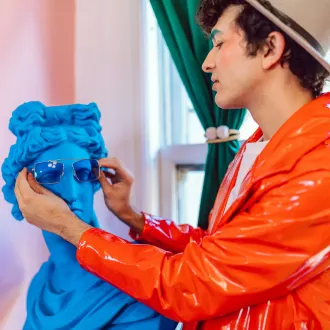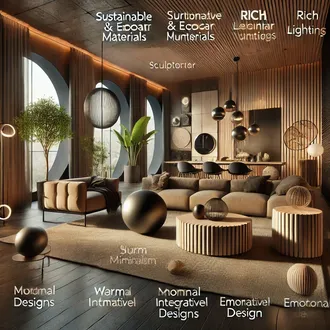Transcription Indoor lighting
Light is an essential element in interior decoration as it enables the appreciation of shapes, colors, textures and benefits people's visual performance, motivation and mood.
The main function of lighting is to contribute to the safe, precise and comfortable performance of all the activities that users carry out in interior spaces. In addition, light, because of its ability to modify the appearance of the elements that make up the space, can direct the attention of users to certain points of interest to contribute to the realization of the decorative idea.
In order for the decorator to master his art to perfection, he has to use light skillfully, so he needs to understand its physical properties and its physiological and psychological effects on man; he must also keep himself informed about the lighting systems that provide more and better performance with a reasonable cost of installation and maintenance and a rational use of energy.
Objectives of indoor lighting
- To provide rooms with a general lighting level that allows users to feel in a safe and comfortable environment when developing the activities for which the interior space was conceived.
- Create spaces with specific lighting levels, according to the activities to be carried out in each area: cooking, shaving, watching TV, reading, writing, etc.
- Use light sources according to the aesthetic effects we intend to achieve, for example: modify the perception of spatial dimensions, highlight elements within decoration, create more social, romantic or intimate atmospheres, etc.
Lighting qualities
Luminous intensity: It is the part of the luminous flux that is projected on a specific area of the room. The luminous intensity depends on three factors:
- On the amount of light from the source that produces it. That means that when selecting a bulb we must know the amount of lumens (lm) it produces -the more lm the bulb produces, the higher the luminous intensity-.
- The distance from the source to the area to be illuminated. The farther away the source is, the weaker the luminous intensity will be in the area.
- The angle of the light rays on the area to be illuminated. The more oblique the rays are, the weaker the luminous intensity will be.
Luminosity: It is the part of the luminous energy that is reflected on the illuminated surface. The degree of luminosity of the surfaces depends on the color and texture of the surface. Therefore, two surfaces that receive equal luminous intensities can cause different luminosity, for example: a light-colored surface reflects more light than a dark one; likewise, a surface with a smooth and shiny texture reflects more light than a rough and matte one.
Contrast: It is the balance that should exist between the relative brightness of the object being observed and the overall brightness. For example: it would be difficult to perceive the details of a bright white object in an environment illuminated with a bright, cold light; the same would be true of a dark object in a dimly lit environment.
Glare: It is the phenomenon caused by the use of very high luminous intensities or by the occurrence of excessive contrasts between dimly and well-lit environments. Glare acts on the retina, desensitizing it for a period of time, causing physiological disorders and psychological discomfort.
There are two types of glare:
- Direct glare: this occurs when the disturbing light comes from light sources - windows, lamps - that are within the visual field.
- Indirect glare: this occurs when the disturbing light comes from shiny surfaces - metallic surfaces, glass, shiny paints, etc. -.
- Light diffusion: This is the phenomenon that occurs when light rays produced by a natural or artificial source pass through something or bounce off a surface and are scattered in different directions, or diffused. This quality of light modifies both the visual atmosphere of the space and the appearance of the illuminated objects; therefore, decorators should use both diffused light sources and concentrated light sources in their projects.
- Diffused light sources are natural light - which enters through windows, doors or glass walls - and artificial light sources that are placed on the ceiling of rooms. These lights provide uniform, glare-free illumination, which is essential for general vision.
- Concentrated light sources are spotlights or lamps that illuminate an area or object with very little diffusion. Concentrated lighting helps to better perceive the contours, shapes, textures and shadows of certain objects within the decorative set.
To generate visual accents and break the monotony that can cause diffused light sources, the decorator should also use concentrated light sources.
The color of light: The color of light is a property that varies according to the light source we use. The appearance of light - its color - is assessed by the color temperature, which is measured in degrees Kelvin (K). Warm light sources (more reddish) are considered to have color temperatures around 2700 K; neutral 4000 K and cold light sources over 5000 K. For example:
- The color temperature of candlelight is about 1500 K, a value approximating that of daylight at dawn.
- That of an incandescent bulb is 2700 K.
- That of a fluorescent bulb is 5500 K.
- LED light sources can be manufactured with different color temperatures -from the warmest to the coolest-.
- The light temperature at noon in a clear sky is 10000 K.
The color of light intervenes in the perception of objects and the moods of users. For example:
- To create a warm, cozy and relaxing atmosphere in a room, the decorator can select a yellowish white light of about 2700 K.
- However, such a light would not be appropriate for a study or reading room, where a cooler light of about 5000 K is required, which in addition to improving vision, stimulates us to be awake, energetic and attentive.
- Likewise, if what is proposed is to create a romantic atmosphere, it would be ideal to use a very warm light of 1500 K, for example: candlelight.
light indoor




